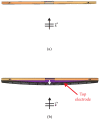Compensation of Heat Effect in Dielectric Barrier Discharge (DBD) Plasma System for Radar Cross-Section (RCS) Reduction
- PMID: 37631659
- PMCID: PMC10459864
- DOI: 10.3390/s23167121
Compensation of Heat Effect in Dielectric Barrier Discharge (DBD) Plasma System for Radar Cross-Section (RCS) Reduction
Abstract
In this study, the problems encountered in radar cross-section (RCS) measurement experiments utilizing a dielectric barrier discharge (DBD) plasma system are examined and an effective solution is proposed. A DBD plasma system generates heat due to the high bias voltage required for plasma generation. The thermal-induced structural deformation of the DBD structure caused by this high voltage and its impact on RCS measurements are analyzed. In addition, techniques for minimizing the thermal-induced deformation and compensation methods for addressing the minimized deformation are proposed. Furthermore, RCS measurements are conducted on two kinds of DBD structures using the proposed method to experimentally demonstrate the improved agreement between the simulation and measurement results. For both structures, the RCS experimental results are in very good agreement with the simulation results, which enables accurate plasma characterization. In conclusion, it can be expected that the proposed method can be used to provide more accurate RCS measurements on various DBD structures that generate high heat.
Keywords: dielectric barrier discharge (DBD); frequency selected surface (FSS); plasma; radar cross-section (RCS).
Conflict of interest statement
The authors declare no conflict of interest.
Figures








References
-
- Knott E.F., Schaeffer J.F., Tulley M.T. Radar Cross Section. SciTech Publishing; New York, NY, USA: 2004.
-
- Robinson C.A., Maxwell J.C. Signal. Volume 2. Clarendon; Oxford, UK: 2007. Radar counters camouflage; pp. 68–73.
-
- MacDonald D., Isenman J., Roman J. Radar detection of hidden targets; Proceedings of the IEEE 1997 National Aerospace and Electronics Conference, NAECON 1997; Dayton, OH, USA. 14–17 July 1997.
-
- Jiang W., Liu Y., Gong S., Hong T. Application of bionics in antenna radar cross section reduction. IEEE Antennas Wirel. Propag. Lett. 2009;8:1275–1278. doi: 10.1109/LAWP.2009.2037168. - DOI
-
- Wang W., Gong S., Wang X., Guan Y., Jiang W. Differential evolution algorithm and method of moments for the design of low-RCS antenna. IEEE Antennas Wirel. Propag. Lett. 2010;9:295–298. doi: 10.1109/LAWP.2010.2047837. - DOI
LinkOut - more resources
Full Text Sources

